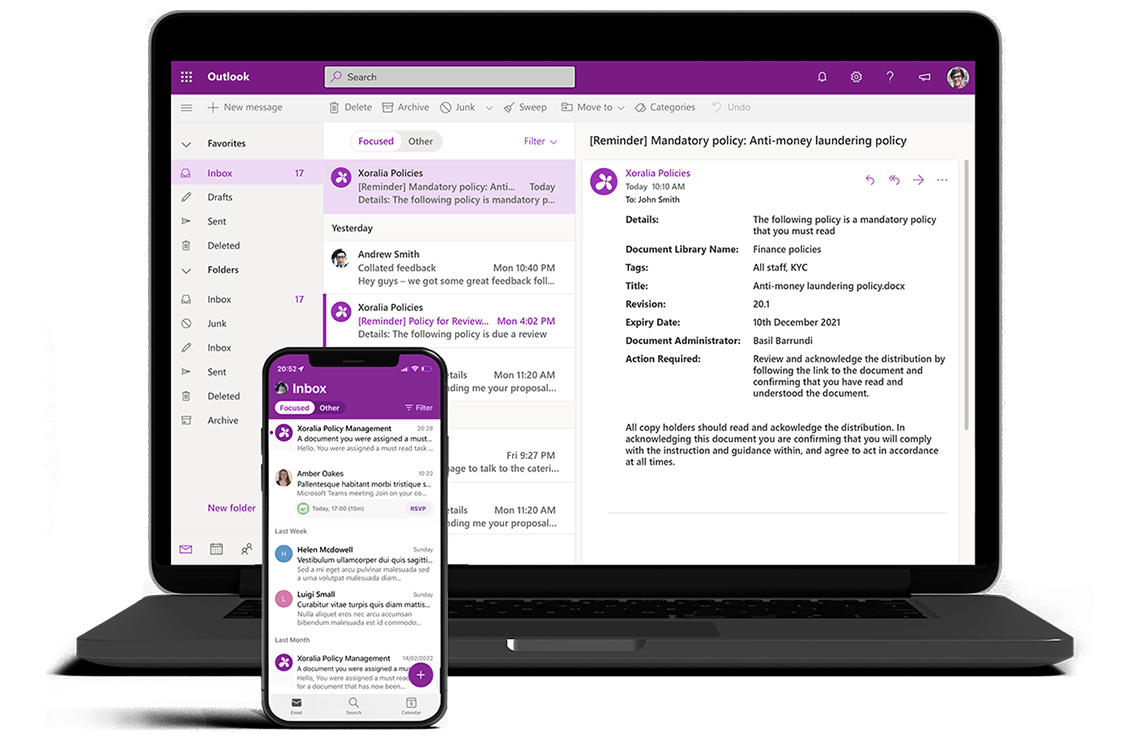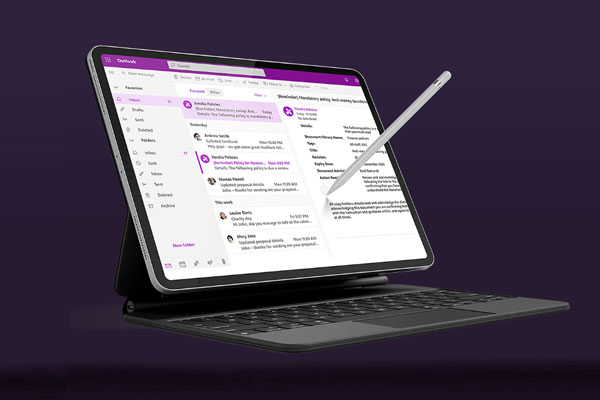Why Xoralia could be just what you’re looking for

Xoralia helps you push out and track mandatory policies in a simple, intuitive interface.
• Target and notify users of their policy tasks
• Track policy reads
• Automate the policy lifecycle
• Keep everything in SharePoint and Teams
In today’s fast-paced business world, effective management of controlled documents such as policies, standard operating procedures (SOPs), work instructions, quality manuals, and regulatory documents is more crucial than ever. The challenge lies not only in creating these documents and keeping them up to date, but also in ensuring that they are readily accessible, understood, and implemented by all employees. This is especially critical in highly regulated industries, where compliance is not just a guideline but a mandate. The pain points in managing controlled documents are significant – they can often be hard to locate, difficult to track, and challenging to enforce, leading to substantial risks for the company.
Pushing out mandatory policies and tracking reads is perhaps the most requested feature in policy management. But before we delve deeper, let’s address other common issues that organisations face with policy management and how tools like SharePoint and Microsoft 365 can help.
Having a single, reliable source for key policies, procedures, forms, and other important documents is vital. Employees and managers need to access information like the staff handbook, IT usage policy, holiday request process, and social media guidelines confidently, knowing that these are accurate and up-to-date.
Most organisations provide access to policies via their intranet, but all too often these are scattered across different department sites and are hard to find, do not get updated with the very latest version, are not read even if they are mandatory, and are not trusted by employees who then request a copy or rely on a version on their own file network or inbox, that may not be up to date.
Many organisations still rely on outdated policy management methods, which can severely hamper their operations. Paper-based processes, while straightforward, are incredibly limited in scope and efficiency. They do not support the dynamic nature of policy updates and make it challenging to disseminate changes swiftly across the organisation.
Similarly, the use of shared drives and spreadsheet applications like Excel, though common, introduces significant challenges. These methods lack the necessary controls for document security, version management, and audit trails, making it difficult to ensure that everyone is accessing the most current policy information. As a result, organisations often face compliance risks and operational inefficiencies.
Email, another frequently used tool in policy management, often leads to cluttered, unmanageable communication threads. While email is essential for day-to-day communications, using it to manage policy updates and acknowledgments can create gaps in information flow and compliance tracking. Important policy communications can easily get lost in an employee’s inbox or become buried under other emails, leading to a lack of accountability and oversight.
These widespread issues with traditional policy management methods, combined with the challenges of using intranets effectively, highlight the need for a more integrated, efficient approach. Modern software solutions offer automation, centralisation, and enhanced reporting, addressing these pain points and transforming policy management into a more streamlined and accountable process.
Seven ways SharePoint is the best place to be storing your policies and procedures
If your organisation is using Microsoft 365 or SharePoint on-premises, then it makes sense to leverage the power of SharePoint to help better manage your policy documents. It offers a number of features right out of the box that solve a number of policy management issues.
1 SharePoint is likely to be your existing and secure document management solution
These days, the majority of organisations use SharePoint or SharePoint Online. Microsoft’s updates to the platform in the last few years – hugely improving it’s ease of use and speed – have made it the go-to choice. This very likely means that it is a familiar tool for most people who create and manage documents and files in your organisation. Documents can be easily shared, collaborated on and there is also effective version control, meaning that you can avoid issues such as duplication and ensure there is one source of truth; this is a critical factor in manging your policies. Leveraging SharePoint for policy management also means that your existing users will be already familiar with the system in place used for managing documents. Of course, SharePoint will also be fully secured and backed up by Microsoft – providing peace of mind.
2 You can automate and track the policy lifecycle with Power Automate
Lifecycle management is absolutely key to successful policy management. For example, you need to make sure that policies have owners who regularly review the documents they are responsible for. SharePoint is excellent from this perspective and you can leverage its integration with Active Directory as well as Power Automate to create clear ownership, notifications and workflow to ensure polices are kept up to date and also create views that show admins the status of policies.
3 SharePoint provides a complete audit trail across versions
As well as lifecycle management you can also get a complete audit trail of updates to your document across current and previous versions, showing when and who made changes. This transparency is important for minimising risks, underpinning accountability, and even for external auditing purposes.
4 SharePoint provides a central place for controlled document access
It is critical to provide easy and centralised access to policies for your employees. As most organisations already use SharePoint for their intranet, project sites or communication sites, it is quick and easy to integrate a policy document library into the channels that employees already have access to.
5 You can integrate it into your search
Policies also need to be findable and discoverable. Again, most organisations are leaning in on SharePoint or Microsoft search options to allow employees to find what they need. Using SharePoint for policy management means that these documents will be included in your main search, perhaps through the intranet, ideally through a dedicated search which is restricted to show search results only from your policy library. And now with CoPilot, Microsoft’s AI offering, it’s even possible to include policy knowledge and content into AI outputs.
6 It can integrate with your wider Microsoft 365 ecosystem
If you are on Microsoft 365 you will likely be using a wide variety of different collaboration and communication tools such as Office Online (Word, PowerPoint, Excel etc.), CoPilot (AI), Viva Engage (previously Yammer), Microsoft Teams, Outlook and SharePoint team sites. The obvious integration between a SharePoint-based policy library and the rest of the Microsoft 365 platform means its easy to embed and share key policies from the library in the places where every day work happens. This not only creates efficiencies but also helps raise awareness of policy and SOP documents.
7 You can track usage and get data
Using SharePoint for policy management means it is also possible to track usage and get data on different policies, for example numbers of views or when they were last updated. By leveraging integrations with Active Directory and PowerBI you can also start to create reports and track critical data such as whether a mandatory document is being read and by whom.
Read more about policy management software and reasons why SharePoint is the best approach here.
Introducing… Xoralia policy management software for SharePoint
Overall, using SharePoint for policy management is the way to go. Having deployed many policies libraries on SharePoint and intranets over the years, we decided to combine all our knowledge into an app which can help customers fast track to a secure, user-centric and robust policy management library.
Xoralia policy management software is a brand-new app designed, developed, and managed by Content Formula. It provides organisations using Microsoft 365 and SharePoint Online a quick-to-deploy central policy library than can be accessed via a SharePoint-based intranet or SharePoint site.
The app is a simple but complete solution that provides:
- Easy, central access to the latest version of organisational policy and procedure documents for all staff
- Robust policy management with assigned content owners and the ability to set scheduled document updates with reviewers and approvers.
- The ability to track readership of mandatory documents, including testing employee knowledge to prove policy understanding
- Dashboards for line managers, document owners and compliance professionals.
- A mobile app for frontline workers who need fast and easy policy access on the move.
- Audit-friendly reporting and audit trails, proving robust policy processes and providing peace of mind.
How it works
In a nutshell, Xoralia policy management software works in the following six simple steps. Find out more about each step and Xoralia policy lifecycle management here.

Document creation and updates

Review and approvals

Version control

Audience targeting and notification

Mandatory reads, attestation and quizzes

Dashboards, tracking and reporting

Policy management software for SharePoint
Xoralia is an intelligent and easy-to-use policy management software for SharePoint, Microsoft Teams and Microsoft Office 365.
Main features
1 All your policies in one place
Xoralia acts as a central policy and procedure library where users can search, browse, and find the latest policies easily. The new AI functionality enhances user interaction by allowing employees to pose questions directly to the system, such as inquiring about the dress code on Fridays or the allowable expenses for a client lunch.
We have designed the system to be as easy to use as possible for all types of employees, even those who do not use a computer in their everyday work such as frontline workers.
Each user has personalised access to the key documents that are important to them and mandatory policies are clearly highlighted, along with read-by-dates.
2 Mobile app for frontline workers
To make life even more convenient for frontline workers such as factory workers, field workers etc, we have built a Xoralia mobile app for iOS and Android. This means they can have access to all the latest policies whilst on the move. No need for a computer or a Microsoft 365 licence!
3 Policy targeting and mandatory reads
Some policies and SOPs are more relevant to some staff than they are to others. This is why Xoralia allows you to target policies to specific users or groups. You can push mandatory policies to users and ask them to confirm they have read and understood a policy. You can even ask them to complete a test to ensure they really have read a policy. All this information is logged by the system.
Of course, not all policies need to be mandatory, but you might still want to target them as ‘recommended reading’. Users may also want to favourite policies for quick and easy access from their favourites list.
4 Automated document lifecycle
It’s best practice for all controlled documents to go through a pre-determined lifecycle. The document lifecycle goes from creation through to publishing and distribution. And when a policy has been live for say, one year, it’s time to check it to see that it is up to date with the latest legal and process changes.
Xoralia helps automate the lifecycle so that nothing gets missed. Document owners, reviewers and approvers are nominated for each document. And each document is associated with its own specific lifecycle. You can design the lifecycle how you want. Maybe you want two approval stages? First the department head needs to approve the policy before it goes to the executive board for final sign off. With Xoralia, all this is possible.
5 Email and Teams Notifications
In order to help people keep on top of their tasks, whether they are mandatory reads or document approvals before go-live, Xoralia sends out notifications. Users can receive these through email or on Teams (or both!). And if a notification is missed and a task remains incomplete, Xoralia sends reminders. It can even escalate to line managers if a task is left undone for too long.
6 Dashboards and reporting
Document owners and compliance professionals always want to be able to see the status of their documents. For example, a document owner might want to check that it is being read by the target audience. They can do this through the intuitive ‘read report’. Another example could be the compliance manager who wants to check that all document owners are carrying out the scheduled updates to their documents on time. For them, Xoralia provides a documents due an update report, clearly showing who is responsible for each document.
An important report is the line manager’s dashboard which is available and personalised to each line manager, showing all their direct reports and the mandatory reads they have been assigned and whether they have completed their read tasks.
Xoralia has a whole variety of dashboards so that all users and stakeholders have all the information they need.
7 Audit-friendly
Modern organisations need to be able to prove the robustness of their policy regime and protocols. Auditors can ask for all sorts of information and Xoralia is there to help, giving you confidence that if there is an audit, you have all the necessary information at your fingertips, whether it’s a report or a marked up policy version.
8 Integrate with your intranet
Xoralia has been built for companies that use Microsoft 365. A key feature is the ability to integrate Xoralia into your intranet pages. Xoralia comes with multiple SharePoint webparts that you can drop onto your intranet pages, where you want them. Each webpart is configurable and displays dynamic information personalised to the individual intranet user.
9 Options for customisation
We’ve built Xoralia to be powerful and extendable. You can integrate with multiple tools across the Microsoft 365 toolset, whether it’s PowerAutomate for workflows, PowerBI for dashboards, Teams, SharePoint, PowerApps – you name it. There’s even an extensive and documented API.
Most customers will find everything they need inside Xoralia, but for those with very specific needs and use cases, the possibilities are infinite!
Customer case study
Gama Aviation provides global business aviation services and support to individuals, corporations and government agencies. The global workforce require access to one source of truth for technical documents, polices and procedures. Building on the SharePoint intranet already introduced by Content Formula, Gama Aviation chose to upgrade their existing policy library to Xoralia to take advantage of the improved UI, mandatory reads capability and decentralised policy management.
Content Formula worked closely with Gama Aviation’s IT function to enable them to carry out most of the implementation themselves. The new policy library is now accessed through the intranet and is widely used across the organisation.
“Xoralia has been a key part of our regulatory process approved by the aviation authority in one of the countries where we operate. We’re very pleased with it.” Daniel Tee, Chief Information Officer, Gamma Aviation.

SharePoint is made for policy management
When it comes to managing your policies and ensuring your employees can find and access them, SharePoint is a strong option.
If you’d like more information about using SharePoint for policy management or about Xoralia policy management software, and would like a product demo then get in touch!
Book a live demo
Find out more about Xoralia policy management software
During the demo, we’ll walk you through Xoralia’s various features and functionality, providing plenty of time for you to ask our experts questions along the way.




